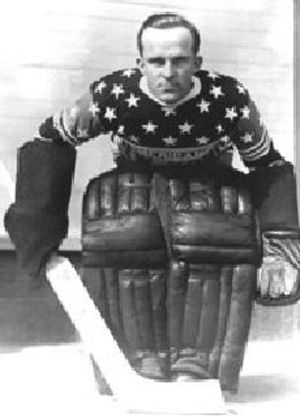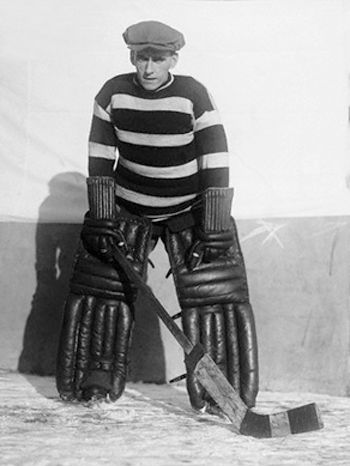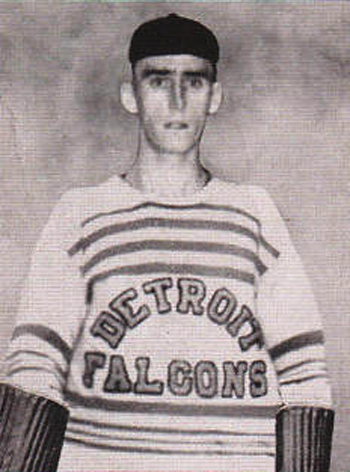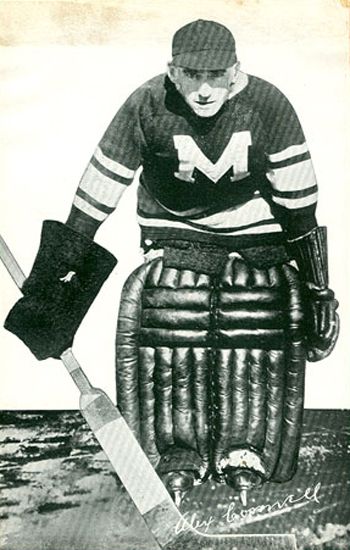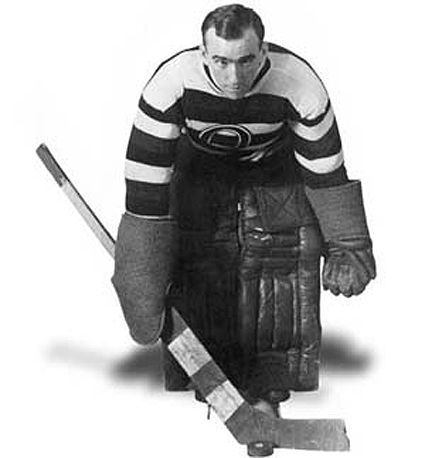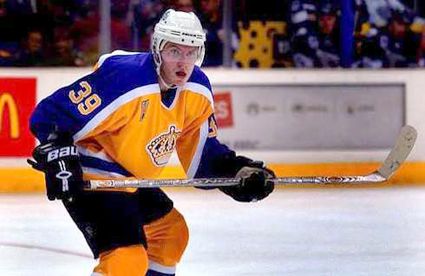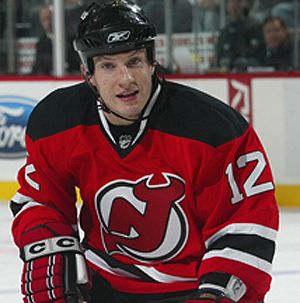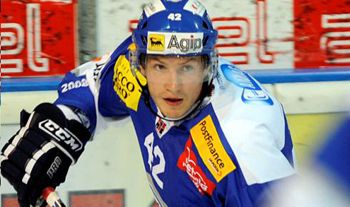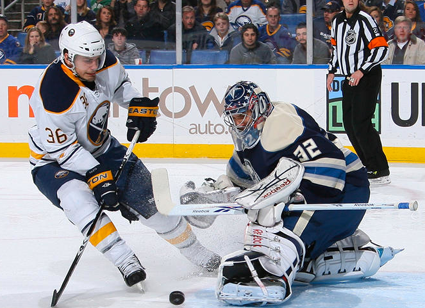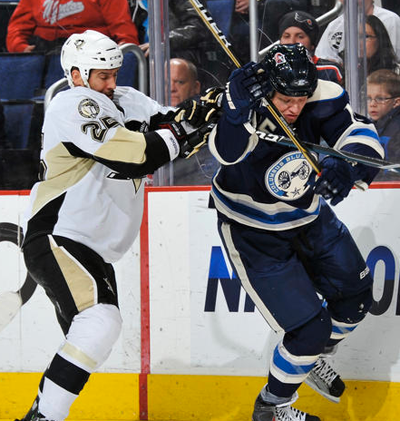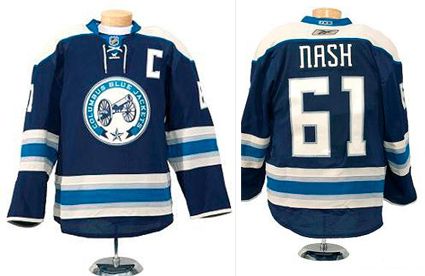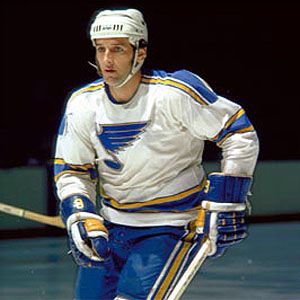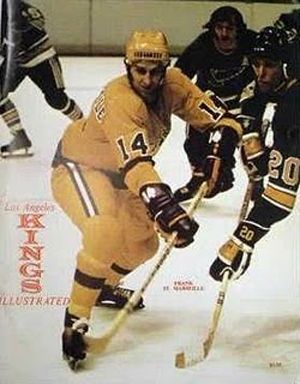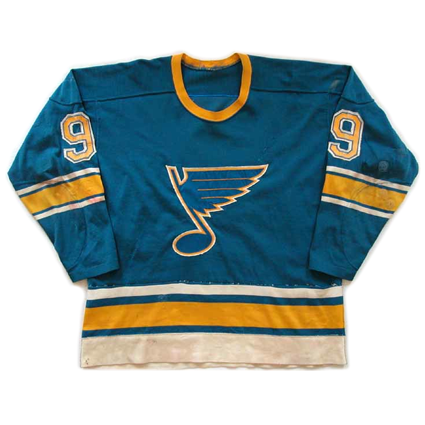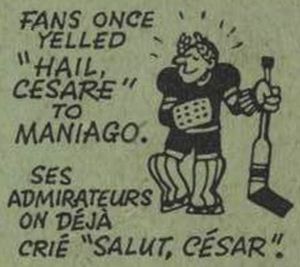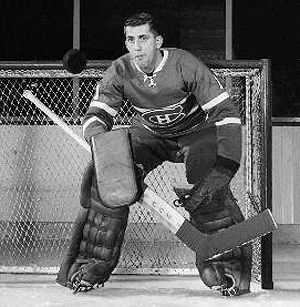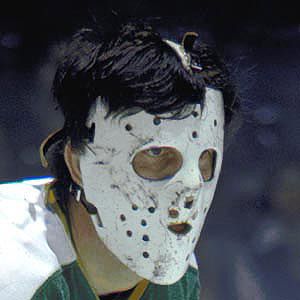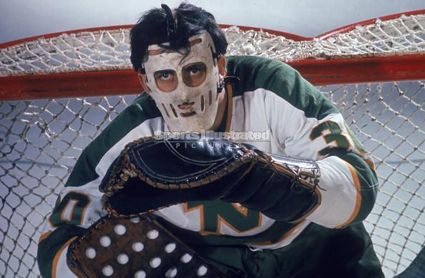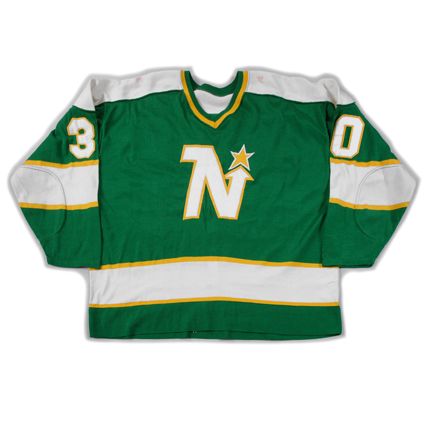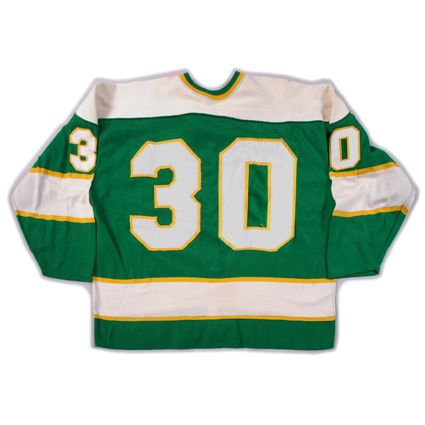
Saturday, December 18, 2010
Third String Goalie Holiday Shopping Guide - Third String Goalie Online Shop Sale!
Still looking for a Christmas gift idea? We are proud to announce the Third String Goalie Online Shop Sale!
Click the image below for The Third String Goalie Online Shop

Third String Goalie Branded Goods Proudly featuring the Patron Saint of Goaltenders Georges Vezina. Prices good through December 31st.
Prices have never been lower and if you order today, you can still receive your item by December 24th while selecting standard shipping!
We have t-shirts, polos, sweatshirts, hoodies, jackets, clothing for kids, tote bags, home & office, mugs and even buttons all featuring our vintage Third String Goalie logo.

Labels:
Holiday Shopping Guide
Friday, December 17, 2010
1930-31 Ottawa Senators Alex Connell Jersey
On this date in 1924 goaltenders Jake Forbes of the Hamilton Tigers and Alex Connell of the Ottawa Sentators battled to the first scoreless tie in NHL history, which came in the eighth season of the NHL.
Forbes had begun his NHL career in 1919 with the Toronto St. Pats with five games in his first season. Forbes played in 20 the following year, going 13-7 and when he refused to accept Toronto's contract offer for 1921-22, he was suspended for the the entire season, missing out on the St. Pats Stanley Cup championship, and was later sold to the Hamilton Tigers.
Forbes played three seasons in Hamilton, improving from 6 wins to 9 and finally 19 to lead the league in wins during the Tigers final season. For 1925-26, the Hamilton franchise was purchased by the New York Americans and Forbes played two and a half seasons with the Americans before being loaned to the Providence Reds and later the Niagara Falls Cataracts.
Jake Forbes
He would spend the next eight years divided between the Canadian-American Hockey League (with New Haven, Springfield and the Bronx) and the International Hockey League (with Windsor, Syracuse, London and Rochester) with occasional fill in duty with the Americans (9 games over four seasons) and the Philadelphia Quakers for two games in 1930-31.
For the rookie Connell, the scoreless tie against Hamilton was the first shutout of his career. After playing five seasons in the Ottawa City Hockey League, Connell was signed by the Senators of the NHL for the 1924-25 season. He would appear in 30 games his first season and post seven shutouts in all. The following season of 1925-26, Connell won 24 games in 36 stars, with 15 shutouts, a career high. In 1926-27, Connell won 30 games, 13 by shutout, in 44 appearances. The Senators would defeat the Montreal Canadiens and then defeat the Boston Bruins in their best-of-five series by the unusual line of 2 wins, no losses and a pair of ties earning Connell his first Stanley Cup.
Ottawa Senator Alex Connell
During the 1927-28 season, Connell set the NHL record for the longest shutout streak of 461:29 by recording six consecutive shutouts. The streak began on January 28th when he held the Montreal Canadiens to single goal in a 2-1 Senators win. The Toronto Maple Leafs then fell 4-0 to Connell and the Senators, who then prevailed 1-0 in overtime over the Montreal Maroons. The New York Rangers battled the Senators to a pair of scoreless ties on February 7th and 9th and the Senators offense again failed to support Connell on the 16th when they tied the Pittsburgh Pirates 0-0. The Canadiens failed to solve Connell while the Senators managed to find the net for the first time in four games to secure a 1-0 win. The streak ended when during Ottawa's 3-2 win over the Chicago Black Hawks on February 22nd. During the final five games of the six consecutive shutouts, the Senators only managed two goals themselves. Connell would finish the season by matching his career high of 15 shutouts.
At least he thought his season was finished. While watching Game 2 of the Stanley Cup Finals between the Maroons and the Rangers, Lorne Chabot of New York was injured and Rangers coach Lester Patrick wanted Connell to come out of the stands to replace Chabot. The Maroons coach Eddie Gerard refused to grant permission for Connell to play, forcing Patrick to famously man the crease himself.
Connell played three more seasons with the Senators prior to being loaned to the Detroit Falcons for the 1931-32 season, as the Senators franchise did not play that season due to financial difficulties. Connell rejoined the Senators for 1932-33 and was named team captain, but would only see action in 15 games compared to the 48 he played for the Falcons the previous season and he retired for the first time at the end of the year.
Alex Connell during his one season with the Detroit Falcons
In 1933-34, the "retired" Connell did see action in a single game when he was loaned to the New York Americans as an injury replacement. He was given a new life for 1934-35 when he was traded to the Maroons and played in 48 games, winning 24, the second highest total of his career. The Maroons then defeated the Chicago Black Hawks one goal to none in their two-game, total-goal quarterfinal series. The Rangers then fell five goals to four to advance the Maroons to the Stanley Cup Finals. Connell and the Maroons then swept the Maple Leafs in three straight games to win the second Stanley Cup of Connell's career.
Stanley Cup champion Alex Connell of the Montreal Maroons
He retired again following the Maroons championship season and was out of hockey for a year but returned to the ice once again to play the 1936-37 season with the Maroons before finally retiring for good this time.
His final totals were 417 games played with a record of 193-156-67 with 81 shutouts and an impressive career goals against average of just 1.91.
Connell was elected to the Hockey Hall of Fame in 1958.
Today's featured jersey is a 1930-31 Ottawa Senators Alex Connell jersey. The Senators familiar barberpole style jerseys underwent a change in in 1929 with the addition of the "O" crest for the first time. The next season the shoulder yoke would be white for just the one season before the struggling Senators sat out the 1931-32 season. When they returned to the NHL, they reverted to the previous style where the stripes repeated all the way to the top of the jerseys for their final two seasons in Ottawa before relocating to St. Louis in 1934-35.
Labels:
Connell Alex,
Forbes Jake,
Ottawa Senators
Thursday, December 16, 2010
2007-08 Lowell Devils Noah Clarke Jersey
Noah Clarke was born in 1979 in La Verne, California, 44 miles from The Forum, home of the Los Angeles Kings. Clarke was nine years old and already a Kings fan when Wayne Gretzky was dealt to the Kings and was no doubt aided and influenced by Gretzky's arrival in Southern California - a phenomenon known as "The Gretzky Effect" which resulted in a dramatic increase in youth hockey in California. Clarke has been quoted as saying that some of the rinks he ended up playing on probably wouldn't have been there if not for Gretzky's presence in Los Angeles.
Clarke moved to Minnesota to play at Shattuck-St. Mary's to further his hockey career, which led to him joining the Des Moines Buccaneers of the United States Hockey League. After two years of play in the junior league averaging more than a point a game as well as being drafted by his hometown Los Angeles Kings, Clarke became a member of Colorado College Tigers of the Western Collegiate Hockey Association under head coach Scott Owens, who had coached Clarke in Des Moines.
Clarke immediately led the Tigers in scoring as a freshman with 37 points in 39 games. After consistent seasons of 32 and 37 points, Clarke exploded for 21 goals and 49 assists for 70 points in 42 games as a senior to lead the nation in assists and finish second overall to teammate and Hobey Baker Award winner Peter Sejna.
Following the conclusion of his college career, Clarke played three games with the Kings minor league affiliate the Manchester Monarchs in preparation for a full season with the Monarchs in 2003-04 as well as a pair of games with the Kings, the first of which came on this date in 2003 when Clarke became the first native Californian to ever play for the Kings in their 37 year history. He also scored his first NHL point with an assist on Jon Sim's goal in the Kings 4-2 win over the Edmonton Oilers.
Clarke in one of his two games with the Kings in 2003-04 wearing the Kings Vintage jersey style
Clarke spent the next three seasons with the Monarchs, including highs of 24 goals and 57 points in the 2006-07 season. Clarke also played another five games with the Kings in 2005-06 and 13 more in 2006-07 which included his first two NHL goals, the first of which came on March 12, 2007, which was also the first Kings goal ever scored by a Californian.
Unable to crack the Kings lineup, Clarke signed with the New Jersey Devils who assigned him to their AHL affiliate, the Lowell Devils. Clarke played 47 games with Lowell, scoring 14 goals and 31 points. He also was called up for a single game with New Jersey in which he scored a goal.
Clarke then moved to Europe to continue his career in 2008-09, first with HC Ambri-Piotta of the Swiss National League A for 28 games before moving to Lukko Rauma of the Finnish SM-Liiga. He returned to HC Ambri-Piotta to start the 2009-10 season before changing teams again, this time moving to Slavia Praha HC in the Czech Republic.
Clarke while with Ambri Piotta in Switzerland
For the 2010-11 season Clarke signed with the Augsburg Panthers of the German DEL.
Clarke concluded his time in the NHL with 21 games, 3 goals and 1 assist for 4 points.
To date, the only other native of California to play for the Kings was Gabe Gauthier of Torrance, California, who skated for the Kings in five games in the 2006-07 season without a point.
Today's featured jersey is a 2007-08 Lowell Devils Noah Clarke jersey from his time with the New Jersey Devils organization. The Lowell Devils came into being when New Jersey moved their minor league affiliation to Lowell, causing the club to change from their previous name as the Lowell Lock Monsters.
The club was founded in 1998 as the Lock Monsters and were originally affiliated with the New York Islanders from 1998 to 2001, then the Los Angeles Kings for a year prior to the Carolina Hurricanes from 2001 to 2006. After two seasons with the Calgary Flames and one with the Colorado Avalanche, the club changed their name and began their final four years in Lowell as the top minor league club of the New Jersey Devils. The 2009-10 season was the final one in Lowell for the club, which relocated to Albany, New York for the 2010-11 season while retaining their affiliation with New Jersey and the Devils name.
While in Lowell, the club won two division titles, the first in 199 and the second in 2002. Playoff success eluded the club however, as they made the playoffs six times in 12 years, never making it past the second round in two tries.
Today's video section begins with a look at the intensity of the fans of Ambri Piotta in Switzerland.
Here in an interview with Clarke following his first NHL goal as a member of the Kings, the first California-born player to ever score for Los Angeles.
Here is a clip of Clarke scoring his only goal while with the New Jersey Devils and an unfortunate slip of the tongue by the announcer while recapping Clarke's stats. Oops.
Labels:
AHL,
Clarke Noah,
Los Angeles Kings,
Lowell Devils
Wednesday, December 15, 2010
2010-11 Columbus Blue Jackets Rick Nash Jersey
The Columbus Blue Jackets unveiled their brand new third jersey on November 24th of this year.
The jersey received mixed reviews with PuckDrawn cleverly and hilariously pointing out the similarity of the new Blue Jackets jersey to the St. Louis Blues 2008-09 blue third jersey with a circular logo, the Pittsburgh Penguins light blue 2008 Winter Classic jerseys with a circular logo, the Florida Panthers 2009-10 blue alternates with a circular logo and the Penguins blue 2011 Winter Classic jerseys with, yes, yet another circular logo.
Personally, we thought the cannon logo looked to much like clip art and being constrained inside the circular banner with the team name shrunk the cannon down in size too much for the fine details of the cannon. We would have preferred the cannon freed from the constraints of the circle, allowing it to be made larger, more stylized, dynamic and intimidating by having it in the act of firing a puck in a dramatic burst of smoke.
We are also most definitely not fans of the font chosen for the numbers, which look like they were applied with duct tape and come across too "digital", giving them a modern, if not futuristic, look, which conflicts with the retro look of the jersey's template, lace-up collar and heritage inspired logo. We are also puzzled by the "blueification" of the jersey, as the color red is completely banished in a manner similar to the Florida Panthers and Nashville Predators alternate jerseys, which delete all the red and yellow respectively from their color palettes.
The Blue Jackets first wore the new third jersey with it's cannon logo on November 26th, a 2-1 loss to the Detroit Red Wings.
In an unusual move, the Blue Jackets again wore their new alternates two nights later, again versus Detroit, only this time on the road at the Joe Louis Arena, apparently gunning for maximum exposure to kickoff the holiday shopping season. That game was also won by the Red Wings, this time by a score of 4-2.
It was back to their normal home blue jerseys on December 1st (a 4-3 shootout loss to the Nashville Predators) before once more wearing the new dark third jerseys, again on the road, against the Buffalo Sabres, who defeated the Blue Jackets by a resounding 5-0 score.
After the thumping they took from the Sabres, it was out of the frying pan and into the fire against the NHL's hottest club, the Penguins, who were riding an eight game winning streak heading into their game with the visiting Blue Jackets, who once more were wearing their alternate jersey for the fourth time in five games. The sad result was a second consecutive five goal loss, this time by a score of 7-2, dropping the new alternate jerseys to a record of 0-4 while being outscored 18-5 in all.
In the Blue Jackets next two games, they defeated Dallas 3-2 at home in a shootout while wearing their home blue jerseys, ending a five game losing streak, and then lost to St. Louis 4-1 wearing their white road jerseys, which had not seen the ice since a win at the New York Islanders on November 24th, the day the new alternates were unveiled.
Now, despite a year and a half in the making, the jersey apparently is now on the outs with the coach and players and may very well be an endangered species. The players and coaches decided to stick with their regular blue home jerseys on December 11th for their game against the New York Rangers, a game which was scheduled to be one of the dates the new alternate jersey was to have been worn. To further justify the decision to stick with their standard home jerseys, the Blue Jackets went out and defeated the Rangers 3-1.
Blue Jackets coach Scott Arniel, when questioned about the absence of the expected third jerseys stated, "I just thought our red pants against their red pants would look really cool. Did it fall on me? I think there are a few fans around the city that were thinking the same thing."
The team's equipment manager Tim LeRoy fell on his sword as he claimed responsibility for the change, "It's my fault, I forgot to put (the third jerseys) out."
Printed inside the collar of each of the new jerseys is "We fight. We march!" but perhaps it should be amended to "We fight! We march! We wear whatever we want!"
A team spokesperson, no doubt pressured by the marketing department, the team's retail manager and any number of large retailers in the Columbus area such as JC Penny and Kohl's, said that the team would again wear the third jerseys for Saturday's game against Dallas.
While the Blue Jackets may not abandon their new alternate jerseys, there have been instances in the past of teams rejecting jerseys after just a few wearings. Some of the most spectacular failures have included British soccer powers Manchester United's ill-fated grey change strip. Losing 3-0 at halftime to Southampton, club manager Sir Alex Ferguson stormed into the locker room and the first words out of his mouth were "Get that kit off, you're getting changed." The shirts had a record of four losses and a tie in four and a half games and were never worn again. Following the change away from the grey jerseys, Manchester United won every one of their remaining games to win the 1996 English Premier League title.
The 1987 Minnesota Twins introduced their new alternate tops in 1997, with the road version being blue, while the home jerseys were red. The red jerseys were first worn at home on Sunday, April 6th and again on April 27th, both losses. After the jerseys were called the "Dairy Queen jerseys" in reference to team sponsor Dairy Queen's red logo positioned behind home plate and their employees red shirts, Twins manager Tom Kelly put a permanent end to the use of the Twins red jerseys.
The NHL is not immune of course, with the two most notorious examples being the alternate jerseys worn by the Mighty Ducks of Anaheim and the Los Angeles Kings in 1996. After being reviled by both players and fans, both jerseys, dubbed the "Wild Wing" and "Burger King" jerseys, were worn approximately 6 times each and immediately retired from use to spare the players and further embarrassment.
Perhaps the most recent example of an "epic fail" is the Dallas Stars "Mooterus" jersey, worn the absolute minimum number of times allowed by the NHL in 2005-06 and then joyously dumped as quickly as possible. "Good riddance," said Stars owner Tom Hicks. "The funny thing is that you can't find anyone around here who will take credit for designing it. Nobody's left."
While the Blue Jackets new jersey may live to see another day, and perhaps another season if their record wearing it improves with time, their alternate mascot "Boomer", introduced in conjunction with the new jersey, looks to be already living on borrowed time due to the juvenile reaction to his apparent phallic resemblance. Not only that, it's been reported that he actually shoots white t-shirts out of the top of his head!
Personally, we think he looks like salt shaker in a wheel chair, but the damage has been done and Boomer (aka "General Phallus") is set to be phased out by season's end.
Today's featured jersey is a 2010-11 Columbus Blue Jackets Rick Nash jersey. While not as notorious as the "Wild Wing" or "Burger King" jerseys, you may want to consider buying one now in case the team does in fact drop this jersey even before reaching the fifteen game minimum for new alternate jerseys according to league rules, as it could become a sought after collectible like many of the other short-lived jerseys in sports history.
Tune in Saturday to see if in fact the marketing department or the coaching staff win the battle of which jerseys the team will wear against Dallas this weekend.
Labels:
Columbus Blue Jackets
Tuesday, December 14, 2010
1970-71 St. Louis Blues Frank St. Marseille Jersey
Considered too slow for the NHL, Frank St. Marseille, born on this date in 1939, was left undrafted by any club in the six team NHL. He played in the International Hockey League with first the Chatham Maroons om 1963-64, scoring 31 goals, before moving to the Port Huron Flags in 1964. There, St. Marseille lit up the league with his offensive game, scoring 38 goals and 97 points in 70 games in his first season in Port Huron.
He backed that up with a 45 goal, 90 point season the following year and in the postseason he contributed six goals and 12 points in nine playoff games as part of Port Huron's balanced scoring attack (eight members of the Flags had between 11 and 13 points) on their way to the 1966 Turner Cup championship.
St. Marseille, #12 on the Third String Goalie list of the Top Twenty Names in Hockey History, then led the Flags in scoring in 1966-67 on the strength of 41 goals and 77 assists for 118 points, which was good for third overall in IHL scoring. His timing could not have been better, as the NHL was about to expand by six teams for the following season, creating approximately 140 new jobs for players previously unable to crack the lineup of one of the Original 6 clubs.
Prior to his outstanding season, St. Marseille was on the radar of the St. Louis Blues general manager Lynn Patrick, who had been sent a letter by St. Marseille's brother Frederick, who was a singer in Los Angeles when Patrick was managing the Los Angeles Blades of the WHL two years earlier, extolling the virtues of Frank.
When Patrick was working on assembling the original Blues roster in 1967, he sent future Hall of Famer Scotty Bowman to scout St. Marseille, who dubbed him "the Gordie Howe of the IHL" and they invited him to the inaugural Blues training camp. Although he impressed at camp, Patrick and Bowman were still skeptical, declaring "he can't be as good as he seems to be", so St. Marseille was assigned to the Kansas City Blues of the CHL, where he proved he was the real deal, scoring seven goals and 15 points in 11 games, which earned him a call up to St. Louis on November 23, 1967 at the age of 28.
He scored 16 goals and 32 points the rest of the season and contributed 13 more points in 18 playoff games as he experienced the thrill of playing in the Stanley Cup Finals in his first season in the NHL.
After a 38 point season the next year, as well as another run to the cup finals, St. Marseille set a career high with 59 points in 1969-70 and a third straight appearance in the finals.
After two more 50 point seasons with the Blues, St. Marseille was traded to the Los Angeles Kings during the 1972-73 season. His first two seasons in Los Angeles resulted in another pair of 50 point seasons, including his best while in Los Angeles of 53 points in 1974-75.
St. Marseille, now 37 years old, saw a drop off in production in his final two NHL seasons, with 26 then 28 points. He played one additional season with the Nova Scotia Voyageurs of the AHL before retiring as a player to become the Voyageurs coach.
His finals NHL totals in 19 NHL seasons were 140 goals and 285 assists for 425 points in 707 games.
Today's featured jersey is a 1970-71 St. Louis Blues Frank St. Marseille jersey. This was the original Blues style first worn in 1967 and remained unchanged until 1973. Following it's use by the Blues, the jerseys from that season were given to a local St. Louis high school and shortened in length by a couple of inches.
Bonus Jersey: Today's bonus jersey is a 1972-73 Los Angeles Kings Frank St. Marseille jersey. Similar to the Blues jersey pictured above, this Kings jersey was recycled by the club for it's own use. St. Marseille's name was removed from this jersey and it was then either used in the following year's preseason games or sent down to the Kings minor league affiliate in Springfield, Massachusetts, who had adopted the Kings name and colors.
Labels:
St. Louis Blues,
St. Marseille
Monday, December 13, 2010
1970-71 Minnesota North Stars Cesare Maniago Jersey
When it was announced in 1965 that the NHL would finally expand after over 20 years of operating as a six team league, Minnesota was a natural location for one of the new six franchises to be granted.
The Minnesota North Stars began play on October 11, 1967 and played their first four games on the road, tying two and losing two, before returning to Minnesota for their first ever regular season game at the brand new Metropolitan Sports Center on October 21st, a 3-1 win over the California Seals, the first victory in franchise history.
After a second win over the St. Louis Blues, the North Stars lost two before putting together a nice run of four without a loss, three wins and a tie, prior to a rugged part of the schedule which featured seven of eight games against established Original 6 clubs. Predictably, they lost six and tied the two others to finish all eight winless.
The final game of that rough stretch was a 1-1 tie versus Montreal, which gave the North Stars a needed boost of confidence, which they used to begin their best stretch of hockey all season. They thumped St. Louis 5-1, earned their first win over the Chicago Black Hawks 4-3 in Chicago before a close-fought 1-1 tie with the defending Stanley Cup champion Toronto Maple Leafs.
A narrow 3-2 loss to the Pittsburgh Penguins at home was only a temporary setback, and they returned the favor in spades the very next night in Pittsburgh by retaliating with a 7-4 win. Then on this date in 1967, Minnesota's Cesare Maniago earned the first shutout in North Stars history with a 4-0 blanking of the Los Angeles Kings in Minnesota.
The two teams then traveled to Los Angeles where Minnesota reiterated it's dominance with another shutout, this time 3-0 with Maniago again in goal. After traveling up the freeway to play Oakland the very next night, Maniago's shutout streak was extended to three consecutive games as the North Stars continued their fine defensive run with a 1-0 victory over the Seals, evening the North Stars record at the time to 11-11-6. He would eventually record three more shutouts in the North Stars first season to set the franchise's benchmark at six.
Maniago made his debut with seven games for Toronto back in 1960 before being claimed by the Canadiens. He would play 14 games with Montreal in 1962-63 but spent several years toiling in the minors waiting for an opportunity to return to the NHL while the Canadiens were winning Stanley Cups on a regular basis with Charlie Hodge and Gump Worsley in goal.
A trade to the New York Rangers provided little opportunity, 34 games in two seasons, before the NHL expanded for 1967-68, creating approximately 140 new NHL jobs, a dozen of those for goaltenders.
The North Stars made Maniago their first choice, instantly changing the course of his career. The notably tall (6' 3") goaltender would spend the next nine seasons in Minnesota, compared to playing for 12 different clubs, including four different ones in both 1960-61 and 1962-63, over the previous seven seasons.
That first season with the North Stars saw Maniago establish what would stand up as his career hight with 22 wins thanks to his quick reflexes and acrobatic style. The following seasons he set another career high with 64 games played. He was traded to the Vancouver Canucks in 1976 and played there for two years before retiring.
He completed his NHL career with 568 games played, 190 wins and 30 shutouts. At the time of his retirement, Maniago was in the top 25 all-time in shutouts and 12th in games played as well as leading the North Stars in every meaningful category.
Today's featured jersey is a 1970-71 Minnesota North Stars Cesare Maniago jersey. The very first North Stars jerseys looked very muchlike this one, only with a lace-up collar and without the white shoulders. The lace-up collar vanished almost immediately during the North Stars first season and the white shoulder yoke was adopted for the North Stars second season of 1968-69. This style would remain in use until 1975.
Labels:
Maniago Cesare,
Minnesota North Stars
Sunday, December 12, 2010
The Poetry of Roberto Luongo
Today we bring you the poetry of Canucks goaltender Roberto Luongo as he waxes on the Sedin twins, Dustin Byfuglien, his backup teammates, the fans chanting his name, shootouts and his gold medal.
Here's a bonus Luongo poem on the Canucks' renowned "Greenmen" supporters.
Or their lack of support, actually...
Labels:
humor
Subscribe to:
Comments (Atom)

